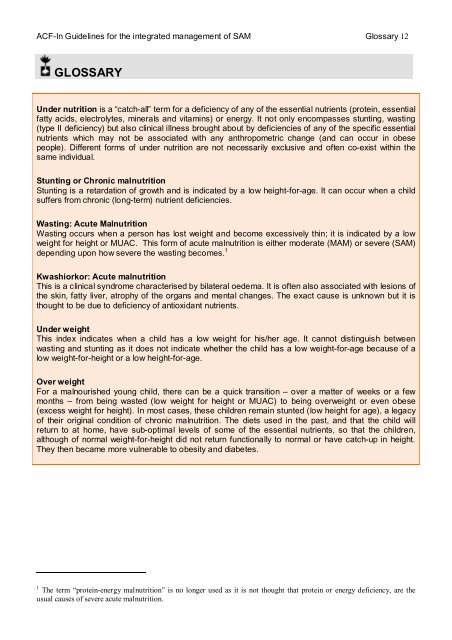guidelines for the integrated management of severe acute malnutrition
guidelines for the integrated management of severe acute malnutrition
guidelines for the integrated management of severe acute malnutrition
You also want an ePaper? Increase the reach of your titles
YUMPU automatically turns print PDFs into web optimized ePapers that Google loves.
ACF-In Guidelines <strong>for</strong> <strong>the</strong> <strong>integrated</strong> <strong>management</strong> <strong>of</strong> SAM Glossary 12<br />
GLOSSARY<br />
Under nutrition is a “catch-all” term <strong>for</strong> a deficiency <strong>of</strong> any <strong>of</strong> <strong>the</strong> essential nutrients (protein, essential<br />
fatty acids, electrolytes, minerals and vitamins) or energy. It not only encompasses stunting, wasting<br />
(type II deficiency) but also clinical illness brought about by deficiencies <strong>of</strong> any <strong>of</strong> <strong>the</strong> specific essential<br />
nutrients which may not be associated with any anthropometric change (and can occur in obese<br />
people). Different <strong>for</strong>ms <strong>of</strong> under nutrition are not necessarily exclusive and <strong>of</strong>ten co-exist within <strong>the</strong><br />
same individual.<br />
Stunting or Chronic <strong>malnutrition</strong><br />
Stunting is a retardation <strong>of</strong> growth and is indicated by a low height-<strong>for</strong>-age. It can occur when a child<br />
suffers from chronic (long-term) nutrient deficiencies.<br />
Wasting: Acute Malnutrition<br />
Wasting occurs when a person has lost weight and become excessively thin; it is indicated by a low<br />
weight <strong>for</strong> height or MUAC. This <strong>for</strong>m <strong>of</strong> <strong>acute</strong> <strong>malnutrition</strong> is ei<strong>the</strong>r moderate (MAM) or <strong>severe</strong> (SAM)<br />
depending upon how <strong>severe</strong> <strong>the</strong> wasting becomes. 1<br />
Kwashiorkor: Acute <strong>malnutrition</strong><br />
This is a clinical syndrome characterised by bilateral oedema. It is <strong>of</strong>ten also associated with lesions <strong>of</strong><br />
<strong>the</strong> skin, fatty liver, atrophy <strong>of</strong> <strong>the</strong> organs and mental changes. The exact cause is unknown but it is<br />
thought to be due to deficiency <strong>of</strong> antioxidant nutrients.<br />
Under weight<br />
This index indicates when a child has a low weight <strong>for</strong> his/her age. It cannot distinguish between<br />
wasting and stunting as it does not indicate whe<strong>the</strong>r <strong>the</strong> child has a low weight-<strong>for</strong>-age because <strong>of</strong> a<br />
low weight-<strong>for</strong>-height or a low height-<strong>for</strong>-age.<br />
Over weight<br />
For a malnourished young child, <strong>the</strong>re can be a quick transition – over a matter <strong>of</strong> weeks or a few<br />
months – from being wasted (low weight <strong>for</strong> height or MUAC) to being overweight or even obese<br />
(excess weight <strong>for</strong> height). In most cases, <strong>the</strong>se children remain stunted (low height <strong>for</strong> age), a legacy<br />
<strong>of</strong> <strong>the</strong>ir original condition <strong>of</strong> chronic <strong>malnutrition</strong>. The diets used in <strong>the</strong> past, and that <strong>the</strong> child will<br />
return to at home, have sub-optimal levels <strong>of</strong> some <strong>of</strong> <strong>the</strong> essential nutrients, so that <strong>the</strong> children,<br />
although <strong>of</strong> normal weight-<strong>for</strong>-height did not return functionally to normal or have catch-up in height.<br />
They <strong>the</strong>n became more vulnerable to obesity and diabetes.<br />
1 The term “protein-energy <strong>malnutrition</strong>” is no longer used as it is not thought that protein or energy deficiency, are <strong>the</strong><br />
usual causes <strong>of</strong> <strong>severe</strong> <strong>acute</strong> <strong>malnutrition</strong>.

















